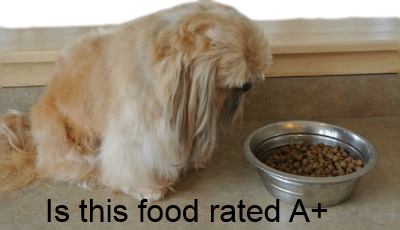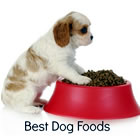Dog Food Rating: A Method for Evaluating Your Dog's Food
Dog food rating is a topic of interest to most health conscious small dog owners. Unless you provide an entirely homemade diet, you will most likely be purchasing a commercially prepared dog food for your small dog. Knowing how to choose one brand over another is important if you want the best for your pet.
Evaluating dog food based on a variety of criteria can be a difficult task when you are trying to determine what food to feed your small dog. Are you wondering how your dog food brand rates based on others available online and in the stores? Everyone who owns a dog wants to know that they are providing an adequate diet, but what exactly constitutes “adequate” in today’s marketplace?
Choosing the best dog food for your pet may seem like a daunting undertaking but it doesn’t have to be impossible if you have the right tools at your disposal.
The rating scale which is listed below was developed by Sarah Irick as a way to evaluate dog foods based on specific ingredients.
Sarah was a Great Dane owner and rescue worker who wanted to provide the best diet for her dogs.
She needed a way to evaluate different dog food brands and developed this scale based on her own research. Coming from the field of engineering rather than veterinary science, this scale is not an exact science, but a useful tool for comparing one food over another.
If you plan to assess your own food, you can use this dog food ratings questionnaire. You will need the dog food package that includes the ingredients list and other information found on the food label. If you have never read a dog food label, check out our introductory article on reading dog food labels.
To do your own dog food ratings, begin with 100 points and then subtract or add based on the criteria below.
Hate math?
Your dog food may have already been evaluated. Click on the Best Dog Food link below to see if your dog food is listed and it rates based on other brands.
Best Dog Foods List:
List of Many Popular Dog Foods that have already been rated.
Begin Your Dog Food Rating with a Score of 100
Begin with 100, then:
- For every listing of “by-product”, subtract 10 points
- For every non-specific animal source (“meat” or “poultry”, meat, meal or fat) reference, subtract 10 points
- If the food contains BHA, BHT, or ethoxyquin, subtract 10 points
- For every grain “mill run” or non-specific grain source subtract 5 points
- If the same grain ingredient is used 2 or more times in the first five ingredients (i.e. “ground brown rice”, “brewer’s rice”, “rice flour” are all the same grain), subtract 5 points
- If the protein sources are not meat meal and there are less than 2 meats in the top 3 ingredients, subtract 3 points
- If it contains any artificial colorants, subtract 3 points
- If it contains ground corn or whole grain corn, subtract 3 points
- If corn is listed in the top 5 ingredients, subtract 2 more points
- If the food contains any animal fat other than fish oil, subtract 2 points
- If lamb is the only animal protein source (unless your dog is allergic to other protein sources), subtract 2 points
- If it contains soy or soybeans, subtract 2 points
- If it contains wheat (unless you know that your dog
isn’t allergic to wheat), subtract 2 points
If it contains beef (unless you know that your dog isn’t allergic to beef), subtract 1 point - If it contains salt, subtract 1 point
Extra Credit:
- If any of the meat sources are organic, add 5 points
- If the food is endorsed by any major breed group or nutritionist, add 5 points
- If the food is baked not extruded, add 5 points
- If the food contains probiotics, add 3 points
- If the food contains fruit, add 3 points
- If the food contains vegetables (NOT corn or other grains), add 3 points
- If the animal sources are hormone-free and antibiotic-free, add 2 points
- If the food contains barley, add 2 points
- If the food contains flax seed oil (not just the seeds), add 2 points
- If the food contains oats or oatmeal, add 1 point
- If the food contains sunflower oil, add 1 point
- For every different specific animal protein source (other than the first one; count “chicken” and “chicken meal” as only one protein source, but “chicken” and “fish” as 2 different sources), add 1 point
- If it contains glucosamine and chondroitin, add 1 point
- If the vegetables have been tested for pesticides and are pesticide-free, add 1 point
Dog Food Rating Scale
94-100+ = A
86-93 = B
78-85 = C
70-77 = D
69 = F
Dog Food Rating Scores
A |
The best foods available for your dog. By feeding these foods, you know that you are providing excellent nutrition for your dog. |
B |
A good choice and highly acceptable. The foods in this category may be slightly less expensive than those rated A or A+ but still offer a good quality diet for your dog. |
C |
These foods are average, not too bad, not too good, but they are acceptable. Consider a higher quality food source when the budget allows you to do so. |
D |
These foods are less than average and are not providing the best food for your pet. Consider change your dog’s diet or supplementing as needed to give a higher quality diet. |
F |
This list includes foods that do not provide the essential nutrients your dog needs for optimal health. If you are using one of these foods, run, don’t walk to the nearest store and choose another brand of food that improves your dog’s health. |
How did your dog food rate based on this scale? Are you feeding an A+ food or something a little less? Remember, before you immediately switching foods, consider the following:
Before You Switch Your Dog Food
- Is your dog in optimal health with not health related issues present? If your dog is doing fine on the food he/she is currently using, there may be no reason to switch brands at this time.
- Check the brand of food you are considering: Have there been any recent recalls?
- Is the dog food you are considering readily available either online or at a local pet store?
- Is the dog food you are considering affordable and well within your budget?
- Is the dog food you are considering palatable to your
dog? Picky eaters may not like all
brands of foods.
If you are making a change, purchase only a small amount and try it out before investing in larger quantities. A high quality food that your dog will not eat is not an economically or nutritionally advisable alternative to your current food.
About Janice (author and voice behind this site)
Having lived with dogs and cats most of her life, Janice served as a veterinary technician for ten years in Maryland and twelve years as a Shih Tzu dog breeder in Ohio.
Her education includes undergraduate degrees in Psychology with a minor in biology, Early Childhood Education, and Nursing, and a master's in Mental Health Counseling.
She is a lifelong learner, a dog lover, and passionate about the welfare of animals. Her favorite breed for over 50 years has been the Shih Tzu, but she has also lived with poodles, Maltese, Yorkshire Terriers, beagles, English bulldogs, carin terriers, and a Cocker Spaniel.
When not writing, reading, and researching dog-related topics, she likes to spend time with her eight Shih Tzu dogs, husband, and family, as well as knitting and crocheting. She is also the voice behind Miracle Shih Tzu and Smart-Knit-Crocheting
Does This Article Deserve Your Thumbs Up?
We always appreciate your support and encouragement. Your thumbs up means so much to us. Please like this article.
If you find this page or any page on Small Dog Place Helpful, or useful in anyway, I'd love it if you would click the small heart found on the bottom right of each page.
You can also share or bookmark this page -- just click on the:

Free Monthly Newsletter
Sign Up for Our Free Newsletter and get our Free Gift to You.
my E-book, The Top 10 Mistakes People Make When Choosing a Dog (and how to avoid them)



